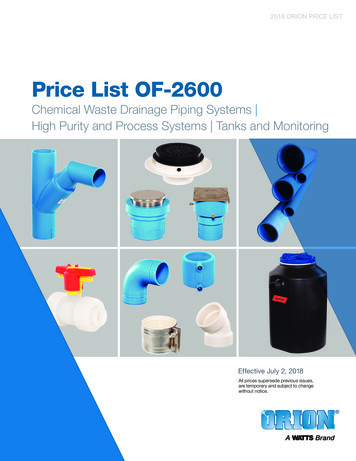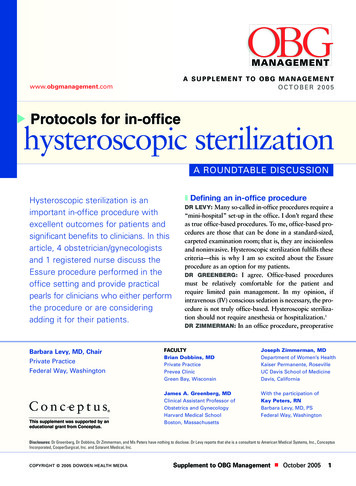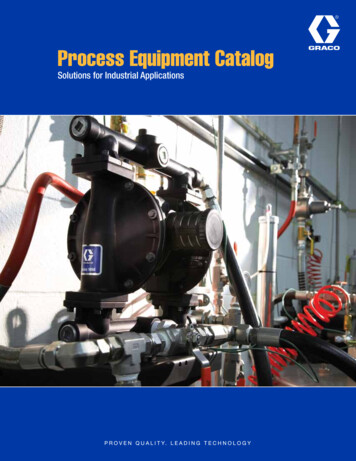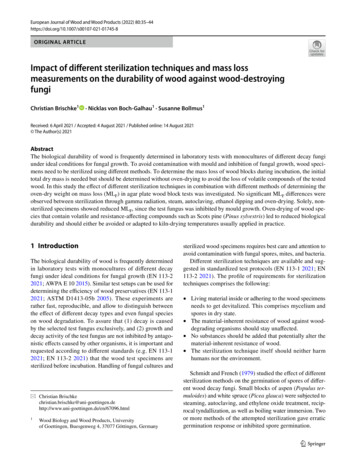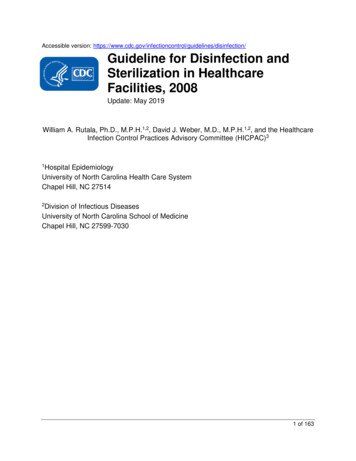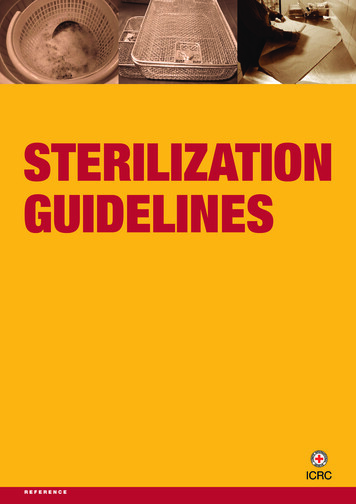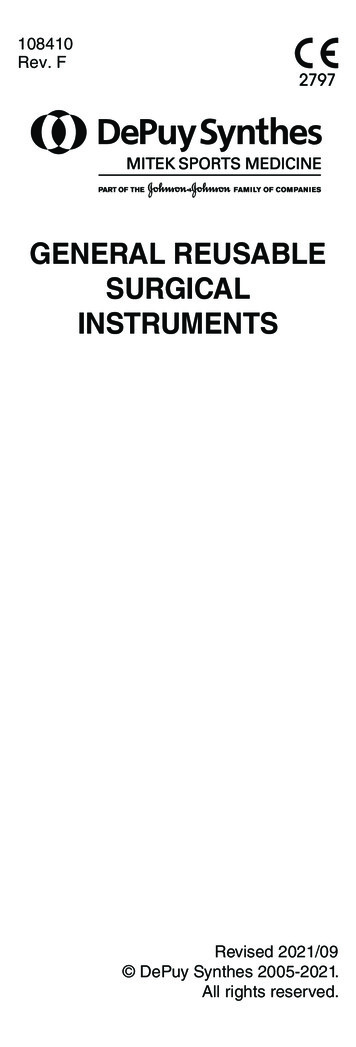
Transcription
STERILIZATION EFFECTS ON POLYPROPYLENE:TECHNOLOGY AND POLYMER TYPE EFFECTSMarkus Gahleitner, Johannes Wolfschwenger and Joachim FiebigBorealis GmbH, St. Peterstr. 25, A-4021 Linz, AustriaKarl Dobianer and Christa HametnerOFI – Institute for Medical Products, Franz-Grillstr. 5, A-1030 Vienna, AustriaAbstract:Polypropylene, one of the most widely used plastics for packaging applications, is increasingly applied also in themedical area and for pharmaceutical packaging, where the material is mostly sterilized. To gain an overview ofsterilizsation effects various polypropylene grades different in structure and additivation were investigated in twoforms – cast film and injection molded – and with five different sterilization techniques. Attention was payed toradiation-induced degradation and thermally stimulated post-crystallization, which continue for a long time after theactual sterilization event. Special copolymers can be an interesting solution to embrittlement problems occurringwith standard grades, but also special stabilization systems can be used.INTRODUCTIONPolypropylene (PP) is one of the most widely used plastics for packaging applications. In a continuously increasingpart of this market, especially in the pharmaceutical area, but also in food packaging and especially in medicalapplications (syringes, pouches, tubes etc.), the material is sterilized in ore or the other way. The use of either heat(steam), radiation (β / electrons or γ) or chemicals (mostly ethylene oxide) affects the mechanical and opticalproperties, but sometimes also the organoleptics of the material significantly.From the literature it becomes clear that the changes are quite different. Radiation, where mostly the effect of γ-rayshas been investigated in the past, induce chain scission and degradation effects [1,2], resulting in a reduced meltviscosity and severe embrittlement. Parallel to that oxidized phenolic antioxidants results in discoloration; thematerial becomes yellow. What makes this radical reaction so critical is the fact that it continues for long times afterthe actual sterilization process, making long-term studies necessary for studying the effects. Various strategies havebeen published for a reduction of these effects, among which the use of “mobilizing agents” (paraffinic oils [3]) andspecial stabilizer formulations [4,5] are most relevant.Steam sterilization, carried out in a temperature range of 120-130 C, results mostly in post-crystallization andphysical aging effects of PP [6,7], while the molecular structure is affected much less in this temperature range. Itnevertheless causes the material to become more stiff and more brittle. Again, also optical disturbances are possiblein the form of significantly increased haze of transparent articles. The post-sterilization changes are significant, butless dramatic than in the irradiation case.While it is rather clear that chemical sterilizing agents like ethylene oxide have a rather limited effect on PP, littleexperience exists so far in public about modern alternative sterilization processes like electron (β) irradiation, UVirradiation and the application of ozone. All of these three methods are capable of forming radicals in the polymer,resulting in similar degradation effects as the γ-radiation.RESULTS OF SCREENING STUDYIn the years 2001/02 a screening study with different types of polypropylene grades supplied by Borealis – standardand experimental materials – in combination with all frequently applied sterilization technologies was performed atOFI Vienna. The study consisted of two parts, cast film samples and injection molded specimens were tested.2003 9th EUROPLACE Conference
Cast Film ResultsThree commercial grades from Borealis plus one stabilizer variation of one of these were used in this part of thestudy (see table 1), for which 200 µm cast films were used. To get a complete picture, five different sterilizationtechniques – steam (121 C, 20 min), γ-irradiation (Co60, 25 kGy), electron irradiation (10 MeV, 25 kGy), ethyleneoxide (10% EtOx, 90% CO2, 55-62 C) and UV-C irradiation ( 0,3 W/cm², 200 nm) – were used, checking theconsequences with mechanical, optical and analytical tests. Molecular degradation effects were investigated withmelt viscosity measurements.GradeTypeRC-P1RH-P1HO-P1RC-VP1Random CopolymerRandom-Heterophasic CopolymerHomopolymerRandom CopolymerMFR 230 C/2,16kgg/10min8888Table 1 – Polymers in first part of screening study (RC-P1 commercial grade RD208CF, RH-P1 commercialgrade Borsoft SD233CF, HO-P1 commercial grade HD822CF, RC-VP1 - same base polymer as RC-P1 withradiation-resistant stabilization)Figure 1 gives a good example of the sterilization consequences on the mechanical properties of the PP film for theexemplary case of the ethylene-propylene random copolymer RC-P1: While the modulus is increased – incombination with embrittlement – by the steam sterilization due to recrystallization, the elongation at break dropsmassively for both irradiation techniques. The effect is even stronger for the γ-radiation sterilization, which actuallyconfirms that β- or electron beam irradiation is less harmful, a fact which was confirmed for all materials. Bothethylene oxide and UV-C irradiation hardly affect the mechanical performance.800Tensile modulusElongation at breakMPa / %6004002000orig.steamgamma electronETOXUVCFigure 1- Effect of different sterilization techniques on tensile properties of the random copolymer RC-P1The main reason for this mechanical “breakdown” lies in the chemical degradation of the polymer, which results in amelt viscosity reduction of nearly two orders of magnitude. This is confirmed for all materials, even for the randomheterophasic grade RH-P1, which retains the mechanical properties best in irradiation as compared to all othergrades (see Figure 2). This effect has been demonstrated before for heterophasic or elastomer-modified PP grades[8,9] in general. The random-heterophasic copolymer, which is characterised by a very fine phase morphology [10]appears to be especially advantageous due to the improved interaction between the random copolymer matrix andthe dispersed elastomer phase, which has been used for filing a patent [11]. The special radiation-resistant addiveformulations [4,5] used in the formulation for RC-VP1 improve the situation somewhat in terms of mechanics andmolecular weight, but the radiation-induced embrittlement is still serious.2003 9th EUROPLACE Conference
The overall picture does not change if the homopolymer grade HO-P1 is included into these considerations. Anotherindependent problem – again mostly in irradiation sterilization – is the discolouration of PP, seen as an increase ofthe yellowness index (YI). The stabilization has an important effect here, especially the experimental radiationresistant formulation reduces this effect significantly in comparison to the standard formulation. Parallel, thedevelopment of soluble and volatile components was first checked with the TOC-level (EN 1484), which reflects thewater-soluble carbon components in the materials. While the TOC-level is originally already low ( 1 mg/m²d) andeven reduced in most sterilization processes for PP, except for the homopolymer HO-P1, which contains a slipagent. A more detailed analysis of the volatile components with GC-MS demonstrated the relative purity of most ofthe PP grades as well. “Critical” components were found to be present in sub-ppm quantities only.800Elongation at break / e 2 – Polymer type effect on embrittlement after γ-irradiationInjection Molding ResultsA limited number of polymer grades – HO-P2 (a nucleated homopolymer with MFR 8, commercial gradeHD810MO), RC-P2 (random copolymer with MFR 20, commercial grade RF830MO) and RC-VP1 (identical tofilm tests) – were used in this part of the study, in combination with the three most frequently used sterilizationtechniques: steam, γ-irradiation and electron irradiation (same parameters as above). The samples tested wereinjection-molded into tensile bars, from which also the specimens for Charpy notched impact testing could be cut. Inview of the results from the first phase, all mechanical, optical and analytical investigations were repeated severaltimes up to a period of 150 days after the sterilization teamDelta Elongation at Break150%-100%Figure 3 - Relative change of the elongation at break for molded tensile bars – 47 days after sterilization2003 9th EUROPLACE Conference
If the elongation at break approximately 50 days after the sterilization event is considered as a primary indicator ofthe sterilization effect (see figure 3), embrittlement effects are most strongly observed for the combination of steamsterilization and RC-P2, while the hompolymer seems to become more ductile in this annealing step. The fact thatthis is reproduced with the irradiations as well probably results from a heating of the specimens in these processesand must be considered with care anyway, as the εB-value of HO-P2 is rather low initially. Even if a directcomparison between the two random copolymers is difficult because of differences in the molecular structure andethylene content, it appears that the alternative stabilization concept used in case of the RC-VP1 gives someadvantage.A slightly different picture, especially for the case of the homopolymer, is obtained if the fracture work value of theCharpy notched impact test (ISO 179 1eA, 23 C) is regarded. The annealing treatment in steam sterilizationimproves the toughness for all materials in case of the injection molded specimens, which is only partially in linewith the extensive experience gathered in earlier studies [12]. The strongest irradiation-related toughness reductionwas found for the homopolymer, which is in line with the rather “normal” stabilizer-package used for this materialand the higher crystallinity [13]. All tests related to pharmaceutical requirements – TOC extractables, UV-VISabsorption and cytotoxicity – showed no critical changes after the sterilization processes.IRRADIATION EFFECTS ON INJECTION MOULDED PPMore detailed investigations have been carried out earlier in relation to the development of radiation-resistant PPgrades at Borealis research. Polymer type, additivation and radiation dose effects were investigated in time series upto 300 days after the sterilization event, which was a γ-irradiation with Co60 / 5 MRad (50 kGy; i.e. twice theintensity used for the screening series outlined before). Injection-molded tensile bars were used, from which also thespecimens for Charpy notched impact testing could be cut. Only part of the results will be presented here,demonstrating polymer and additivation effects with four grades as listed in table 2.GradeHO-VP1HO-VP2RH-VP1RH-VP2TypeMFR 230 C/2,16kgg/10minHomopolymer20Homopolymer *20Random-Heterophasic Copolymer 18Random-Heterophasic Copolymer 2**8Table 2 – Polymers in radiation effect study (* - same polymer as HO-VP1 with radiation-resistant stabilization,** - same polymer as RH-VP1 with radiation-resistant stabilization)Figure 4 clearly demonstrates the dominating importance of the polymer structure, again showing the superiorresistance of random-heterophasic copolymers to radiation-induced degradation effects. The sole use of a radiationresistant additive formulation (which was different from the formulation used in the OFI screening study outlinedbefore) was not sufficient to drastically reduce the embrittlement of the homopolymer, but it gave positive effects interms of discoloration (i.e. a reduced increase of the yellowness index) and impact strength.A possible explanation for the general superiority of heterophasic systems lies in the different reaction of the PPmatrix and the dispersed elastomeric phase to radical reactions, which can also be seen in visbreaking (peroxidecontrolled degradation) of heterophasic copolymers [14]. Random-heterophasic systems have the additionaladvantage of a very fine phase structure resulting from viscosity adaption and improved compatibility between thephases, resulting in improved transparency.2003 9th EUROPLACE Conference
800Elongation at break / 300350Time / daysFigure 4 – Time dependent decrease of the elongation at break after γ-irradiation for four different PP gradesSTEAM STERILISATION EFFECTS ON PP CAST FILMExtensive work on post-crystallization and physical aging of PP was done at Borealis reasearch in connection withan EU-funded project on crystallization effects in polymer processing and have been mostly reported before [7,12].In most cases also a sterilization-related annealing step of 121 C / 0,5 h was tested, with successive measurementsof mechanical and optical properties for a period up to 330 days. An interesting aspect of these studies was the effectof processing conditions, especially in the case of cast films [15], especially the pronounced effect of the”quenching”-type solidification. As outlined before, the use of very cold chill rolls leads to a suppression ofcrystallization (also seen in the group of Piccarolo [16]), resulting in stronger property changes in the postprocessing phase.In the cast-film part of these studies three structurally different PP grades (all with a standard additivation, see table3) were tested after extrusion of 50 µm films on a 50 mm Battenfeld single screw extruder equipped with a 1000mm wide slit die in a thickness of 50 µm and trimmed to a width of 800 mm. The processing conditions were variedby changing the temperatures of the chill rolls; only results from “cold” rolls (15-25 C) will be discussed here.Tensile tests, penetration tests ( 23 C, Dynatest) and haze tests were done in time series on the original (nonannealed) and the “sterilized” (annealed) films.GradeTypeHO-P3RC-P1HC-VP1HCPP HomopolymerRandom CopolymerHeterophasic CopolymerMFR 230 C/2,16kgg/10min884Table 3 – Polymers in cast-film part of ageing study (HO-P3 – high-crystallinity PP with increased isotacticity,commercial grade Bormod HD905CF; RC-P1 – as before; HC-VP1 – experimental grade)2003 9th EUROPLACE Conference
3Rel. modulus & work / -Tens. modulus2,521,510,5Dynatest01101001000Time / hFigure 5 – Relative development of modulus and penetration work (Etotal from Dynatest)for RC-P1 cast films (50 µm), open symbols – original samples, full symbols – sterilized samples (121 C / 0,5 h)To get a general view at the development of film mechanics in ageing and annealing, figure 5 summarizes themodulus and penetration results for the random copolymer RC-P1. A logarithmic time scale was used as in earlierpresentations [12] to underline the ongoing mechanical changes even long times after processing. The sterilizationstep increases the crystallinity of the films significantly for all materials, resulting in a modulus and haze increasetogether with significant embrittlement. Table 4 summarizes the mechanical consequences of room-temperatureaging and clearly shows that only in case of the heterophasic copolymer the original impact strength can be retainedin a significant amount.GradeHO-P3RC-P1HC-VP1Tensile izedMPa1568637840Etotal ilizedJ0,040,280,94Table 4 – Cast film mechanics of PP-grades in the aging study; “original” values 24 h after processing,“aged” 336 days after processing, “sterilized” 336 days after steam sterilization (121 C / 0,5 h)CONCLUSIONSBoth the applied sterilization technology and the polymer type in connection with the stabilizer formulation usedstrongly affect the changes in composition, mechanics and optics resulting from a sterilization step. The differenteffects of the two mostly used techniques – steam and γ-irradiation – are related to the mechanisms induced:Degradation for the irradiation and post-crystallization for steam. Special copolymers are the most interestingsolution to embrittlement problems ocurring with standard grades, but also special stabilization systems also cangive some advantage, especially for reducing the discoloration problems.2003 9th EUROPLACE Conference
ACKNOWLEDGEMENTSThe screening study at OFI Vienna was partly financed by the Austrian FFF under Project No. 804945 Part of thepost-crystallization studies was carried out in the framework of the Brite-Euram project “DECRYPO” funded by theEuropean Commission. The authors are also grateful to Roberto Todesco of Ciba Speciality Chemicals for designingthe alternative stabilization for RC-VP1 and to Manfred Kirchberger and Stefan Ortner of Borealis GmbH Linz,Austria, for helpful discussions.References1 – Martakis, N., Niaouniakis, M., and Pissimissis, D., “Gamma-sterilization effects and influence of the molecularweight distribution on the postirradiation resistance of polypropylene for medical devices”, J.Appl.Polym.Sci. 51(2),pp. 313-328 (1994)2 – Thorat, H.B., Prabhu, C.S., Suresh, K.K., and Pandya, M.V., “γ-Ray-Induced Degradation in Ethylene-PropyleneCopolymer”, J.Appl.Polym.Sci., 59 (11), pp. 1769-1773 (1996)3 – Williams, J.L., Dunn, T.S. and Stannett, V.T., “Mobility as a Mechanism for Radiation Stabilization ofPolypropylene”, Radiat.Phys.Chem., 19 (4), pp. 291-296 (1982)4 – Klemchuk, P.P., “Protecting Polymers Against Damage from Gamma Radiation”, Radiat.Phys.Chem., 41 (1/2),pp. 165-172 (1993)5 – Moore, E.P, “Polypropylene compositions resistant to radiochemical sterilization”, US 4888369 for Himont Inc.,USA6 – O’Kane, W., Young, R.J., and Ryan, A.J., “The Effect of Annealing on the Structure and Properties of IsotacticPolypropylene Films”, J.Macromol.Sci.-Phys., B34 (4), pp. 427-458 (1995)7 – Fiebig, J., Gahleitner, M., Paulik, C., and Wolfschwenger, J., “Ageing of Polypropylene: Processes andConsequences”, Polym.Testing, 18 (4), pp. 257-266 (1999)8 – Sterzynski, T. and Thomas, M., “Gamma Radiation Induced Changes in the Structure and Properties ofCopolymers of Propylene”, J.Macromol.Sci.-Phys. B34 (1&2), pp. 119-135 (1995)9 – Portnoy, R.C., “Clear, Radiation Sterilizable, Autoclavable Blends Based on Metallocene Catalyzed PropyleneHomopolymer”, SPE ANTEC, 75 (Vol. 3), pp. 3011-3015 (1999)10 – Starke, J.U., Michler, G.H., Grellmann, W., Seidler, S., Gahleitner, M., Fiebig, J. and Nezbedova, E., “FractureToughness of Polypropylene Copolymers: Influence of Interparticle Distance and Temperature”, Polymer, 39(1) pp.75-82 (1998)11 – Bernreitner, K. and Wolfschwenger, J., “Use of thermoplastic elastomers for improving the stability ofpolyolefins to ionizing radiation”, EP 857755 B1 for Borealis GmbH., Austria12 – Gahleitner, M., Fiebig, J., Wolfschwenger, J., Dreiling, G. and Paulik, C., “Post-Crystallization and PhysicalAgeing of Polypropylene: Material and Processing Effects”, J.Macromol.Sci.B – Phys., B41 (4-6), pp. 833-849(2002)13 – Kadir, Z.A., Yoshii, F., Makuuchi, K. and Ishigaki, I., “Durability of radiation-sterilized polymers: 12. Theeffects of nucleatioting agent on the oxidative degradation of polypropylene”, Polymer, 30 (8), pp. 1425-1432(1989)14 – Gahleitner, M., Paulik, C., Bernreitner, K. and Neißl, W., “Degradation and Crosslinking Effects in HighImpact Polypropylene Copolymers”, Proc. of PPS America Meeting, Toronto/CD, pp. 49-50 (1998)15 – Macauley, N.J., Harkin-Jones, E.M.A. and Murphy, W.R., “The Influence of Nucleating Agents on theExtrusion and Thermoforming of Polypropylene”, Polym.Eng.Sci. 38 (4), pp. 662-673 (1998)16 - Gerardi, F., Piccarolo, S., Martorana, A. and Sapoundjieva, D., “Study of the long-period changes in samples ofisotactic poly(propylene) obtained by quenching from the melt and subsequent annealing at different temperatures”,Macromol.Chem.Phys., 198 (12), pp. 3979-3985 (1997)2003 9th EUROPLACE Conference
Sterilization Effectson Polypropylene:Technology andPolymer Type EffectsMarkus Gahleitner, Johannes Wolfschwengerand Joachim FiebigBorealis GmbH, Linz / AustriaKarl Dobianer and Christa HametnerOFI – Institute for Medical Products, Vienna / Austria
Content Why did we do it ?How do methods & polymersaffect the sterilization results ?What happens in detailwith γ-irradiation ?What happens in detailwith steam ?Which conclusions can be drawn ?
Why did we do it ?Î Polypropylene (PP) increasingly used formedical applicationsÎ Sterilization used also in otherapplication areas of PP (food &pharmaceutical packaging)Î Use of heat (steam), radiation (β / electronsor γ) or chemicals (mostly ethylene oxide)affects the mechanics, optics &organoleptics significantlyÎ Different combination of polymer & stabilizersystem might be necessary for differentmethods
Different methods different effects .Î Radiation (β / electrons or γ) induces chainscission process(via radicals) resulting in degradation, phenolicantioxidants oxidized in this process lead todiscolorationÎ Steam sterilization (temperature range of 120130 C) results mostly in post-crystallizationand physical aging effects of PP embrittlement & haze increaseÎ Ethylene oxide sterilization least damagingÎ Effects largely unknown for alternativemethods (e.g. UV-C)
Screening study at OFI - Cast films (1/3)Î 4 different PP grades (see table) in cast films (200 µm)Î 5 different sterilization techniques – steam (121 C, 20 min),γ-irradiation (Co60, 25 kGy), electron irradiation (10 MeV,25 kGy), ethylene oxide (10% EtOx, 90% CO2, 55-62 C) andUV-C irradiation ( 0,3 W/cm², 200 nm)Î mechanical, optical and analytical tests doneGradeTypeMFR 230 C/2,16kgg/10minRC-P1 Random Copolymer8RH-P1Random-Heterophasic Copolymer8HO-P1 Homopolymer8RC-VP1 Random copolymer*8* - same polymer as RC-P1, radiation-resistant stabilizer package
Screening study at OFI - Cast films (2/3)800Tensile modulusElongation at breakMPa / %6004002000orig.steamgamma electronETOXUVCEffect of different sterilization techniques on tensile propertiesof the random copolymer RC-P1 (EP random copolymer))ª modulus increase & embrittlement for steam sterilizationª massive drop in εB for irradiation techniques (slightly less for β)
Screening study at OFI - Cast films (3/3)800Elongation at break / er type effect on embrittlement after γ-irradiationª random-heterophasic grade retains mechanical properties bestin irradiationª radiation-resistant additives improve the situation slightly
Screening study at OFI - IM specimens (1/3)Î 3 different PP grades (see table) in injection-moldedtensile barsÎ 3 different sterilization techniques – steam (121 C, 20 min),γ-irradiation (Co60, 25 kGy) and electron irradiation (10 MeV,25 kGy)Î mechanical, optical and analytical tests done time series after sterilization event (up to 150 days)GradeTypeRC-P2 Random Copolymer (nucleated)HO-P2 Homopolymer*RC-VP1 Random copolymer*** - radiation-resistant stabilizer package** - identical to cast film testsMFR 230 C/2,16kgg/10min2088
Screening study at OFI - IM specimens eamDelta Elongation at Break150%-100%Relative change of the elongation at break (after 47 d)ª strongest embrittlement for the combination of steam sterilization andrandom copolymer (better performance of lower MFR grade in irradiation)ª εB-increase for homopolymer rather irrelevant because of low start level
Screening study at OFI - IM specimens (3/3)1E 04Viscosity 230 C / Pa.s1E 04RC-P2HO-P2RC-VP1γ-irradiationVapourViscosity 230 C / Pa.sDifferences in degradationeffects (monitored via meltviscosity, dynamic test) betweensterilization techniques .RC-P2GammaElectrons1E 031E 0201020304050Time / days1E 03 and polymer / stabilizer typesare reflected in time-dependentembrittlement (mostly for the twoirradiation techniques)1E 020102030Time / days4050
γ-irradiation effects in detail (1/3)Î 4 different experimental PP grades (see table) ininjection-molded tensile barsÎ sterilization technique γ-irradiation (Co60, 50 kGy) - twice ashigh as in screening series!Î mechanical, optical and analytical tests done time series after sterilization event (up to 300 omopolymer *Random-Heterophasic Copolymer 1Random-Heterophasic Copolymer 2**MFR 230 C/2,16kgg/10min202088* - same polymer as HO-VP1 with radiation-resistant stabilizer package** - same polymer as RH-VP1 with radiation-resistant stabilizer package
γ-irradiation effects in detail (2/3)Elongation at break / 250300350Time / daysTime dependent decrease of the elongation at breakafter irradiationª strongest embrittlement for homopolymers within 50 daysª random-heterophasic grades retain 50% of their toughness
γ-irradiation effects in detail (3/3)Additional findings on γ-irradiation:Î no critical increase of TOC-level in any caseÎ radiation-resistant stabilizer packages not sufficient foravoiding embrittlement, but reducing discolorationÎ general superiority of heterophasic systems lies in thedifferent reaction of the PP matrix and the dispersedelastomeric phase to radical reactions0,5 µmPhase morphology (TEM after RuO4 staining) ofrandom-heterophasic copolymer(RH-P1 from screening series)
Steam sterilization effects in detail (1/3)Î 3 different experimental PP grades (see table) in50 µm cast films (cold chill-roll)Î sterilization technique steam (121 C, 20 min among other annealing conditions)Î mechanical, optical and analytical tests done time series after sterilization event (up to 330 days)GradeTypeHO-P3 HCPP Homopolymer*RC-P1 Random Copolymer**HC-VP1 Heterophasic Copolymer* - high-crystallinity grade with increased isotacticity** - identical to screening series cast filmMFR 230 C/2,16kgg/10min884
Steam sterilization effects in detail (2/3)Rel. modulus & work / -3Tens. modulus2,521,510,5Dynatest01101001000Time / hRelative development of modulus and penetration work(Etotal from Dynatest) after steam sterilization for RC-P1ª sterilization step increases film crystallinity significantly for all gradesª modulus and haze increase together with significant embrittlement
Steam sterilization effects in detail (3/3)Additional findings on steam sterilization:Î no critical increase of TOC-level in any case, butdiscoloration and haze increase can be significantÎ special stabilizer packages rather uselessÎ only in case of the heterophasic copolymer the originalimpact strength can be retained in a significant amountGradeTens. 072,52agedJ0,071,281,42sterilizedJ0,040,280,94Cast film mechanics of PP-grades in the aging study“original” values 24 h after processing, “aged” 336 days afterprocessing, “sterilized” 336 days after steam sterilization (121 C / 0,5 h)
ConclusionsÎ Applied sterilization technique andpolymer / stabilizer type strongly affectchanges in composition, mechanicsand optics resulting from sterilizationÎ Effects of two mostly used techniques steam and γ-irradiation - related inducedmechanisms: Degradation for irradiationand post-crystallization for steamÎ Special copolymers are the most interestingsolution to embrittlement problemsoccurring with standard gradesÎ Special stabilization systems can give someadvantage for reducing discoloration
Thanks to . FFF Austria for partly financing the screening study atOFI Vienna under Project No. 804945The European Commission for funding the Brite-Euramproject “DECRYPO” (film aging studies)Roberto Todesco of Ciba Speciality Chemicals for helpwith the radiation-resistant stabilizationManfred Kirchberger and Stefan Ortner of BorealisGmbH for helpful discussions
Injection Molding Results A limited number of polymer grades - HO-P2 (a nucleated homopolymer with MFR 8, commercial grade HD810MO), RC-P2 (random copolymer with MFR 20, commercial grade RF830MO) and RC-VP1 (identical to film tests) - were used in this part of the study, in combination with the three most frequently used sterilization
